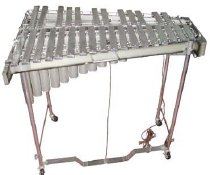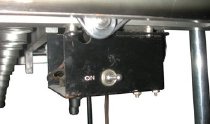Object Record
Images



Metadata
Catalog Number |
1994.05.01 |
Object Type |
Vibraphone |
Creator |
J. C. Deagan, Inc. |
Title |
Model 30 Vibraharp |
Description |
Deagan Model 30 Vibraharp, 2.5 octave (C4-F6). Bars are chromed with note names on each. Lowest bar (C) reads: "J.C. DEAGAN INC. / CHICAGO / MADE IN U.S.A." and "DEAGAN / NO 30 / VIBRA-HARP / REG. U.S. PAT. OFFICE".Thin metal frame with wood rail pieces painted blue and grey. Cardboard resonators with metal caps. Serial # 2841. |
Dimensions |
H-32.5 W-38 L-37.5 inches |
People |
J. C. Deagan, Inc. |
Date |
c. 1940 |
Additional Research |
Manufactured by the J.C. Deagan Company between 1938-1942, the Model 30 Vibraharp was lightweight and portable. From the inception of Deagan's vibraharp and Leedy's vibraphone, the standard range had been 3 octaves, F to F. In order to reduce the weight of the instrument, Deagan eliminated the lowest (and largest) keys, which resulted in a 2 1/2 octave C to F range. The stand size was reduced to a simple straight-legged support system, with a thin pedal, both of which had less mass than prior vibraharp designs. A third change was to use cardboard, instead of brass, for the resonators. The cardboard resonators were capped on the end with metal and suspended in a box frame to provide adequate support. The motor, used to rotate the fans, had only one speed. For ease of transport, the legs and pedal can be quickly disassembled and the enitre instrument placed into a single canvas bag. A prominent handle, used for carrying the instrument, extends from the two-tone, duco-finished frame. When first introduced in 1938, the instrument sold for $195, and when it was discontinued n 1943, it listed for $260.-Percussive Notes, April 2008 Deagan Model 30 Vibraharp Chicago c.1940 The Model 30 Vibraharp, with a 2 1/2-octave range, is a smaller version of Deagan's famous three-octave Model 145, introduced a decade earlier in 1927. The J.C. Deagan Company's principal rival in the manufacture of bar-instruments had always been the Leedy Drum Company. Leedy's new metal-bar instrument, called the Vibraphone (1924), was equipped with rotating discs beneath each bar designed to pulsate the resonant sound. Desiring to compete for their share of the profitable new market, Deagan offered a comparable (and closely named) instrument, the Vibraharp in 1927. It featured a new pedal-activated felt pad designed to stop the sound of the resonating bars. Leedy threatened legal action to stop the development of the Deagan Vibraharp, claiming patent infringement. The conflict was settled out of court when Leedy traded to Deagan the right to use their motor-driven fans in exchange for their use of the Deagan pedal. From that time forward, metal-bar instruments produced by these competitors offered the resonator fans and the damper pedal. These design elements are both present in this Model 30 Vibraharp that Deagan produced between 1938 and 1942. Donated by Ward Durrett PAS Museum Exhibit Label |
Credit line |
Gift of Ward Durrett |
